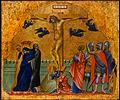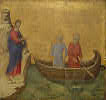Tour: Byzantine Art and Painting in Italy during the 1200s and 1300s
| Overview | Start Tour | ||
 |
 |
|
| 1 | 2 | 3 |
 |
 |
 |
| 4 | 5 | 6 |
| » | next | |||
| « | back to Italian painting of the 13th-14th centuries | |||
Overview
Many of the Gallery’s early Italian paintings were originally parts of altarpieces, a form that first appeared in Italy in the thirteenth century as new attention was focused on the altar by changes in the liturgy, church architecture, and the display of relics. Painting on wooden panels had not been common in the West, but by this time the gilded and painted panels of elaborate altarpieces had begun to join—and would eventually overshadow—fresco and mosaic as the principal forms of decoration in Italian churches. Western artists working on panel turned for inspiration to the Christian East, adapting the techniques, style, and subject matter of Byzantine icons. For Byzantine Christians—and Orthodox Christians today—the icon was a true copy of its holy model. Theologians used the analogy of a wax impression and the seal used to create it to describe the relation between an icon and its subject. Because they depict a holy and infinite presence, not the temporal physical world, icons avoid direct reference to earthly reality, to specific time or place. Instead, backgrounds are dematerialized with shimmering gold, settings are schematized, and figures often appear timeless and static.
(continue)
Captions


